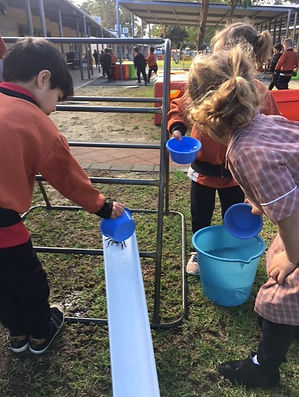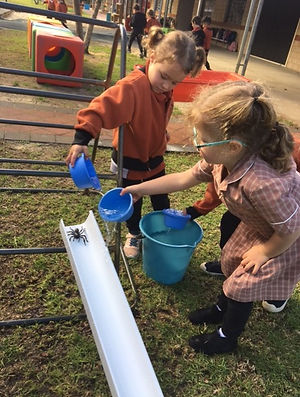3.3 Use teaching strategies
AITSL Standard 3.3 Example 1
I provide students with open-ended play-based learning which is implemented in a similar way to any other teaching strategy and is an excellent teaching strategy for young children. Before the activity, I set educational goals, ensured that all resources were available and took a risk-based approach to predict and prevent injury. The students were learning about spiders and our focus for Talk for Writing was Incy Wincy Spider. I provided the students with loose PVC piping of different sizes and joiners of different angles, some with a screw cap to allow for 3 way exit points, see photo below, left. I discussed with the students the aim of the activity and the students created 'water spouts' in so many combinations and variations and tested them to see if a plastic spider could travel through the pipes. This was a hands on activity involving problem solving, critical thinking and creative thinking. The students were guided by their own play and discovery with the given materials and didn't need much adult intervention. Please see the students work in Figures 2 and 3.


Figure 1 - Loose PVC piping of different sizes and joiners of different angles, some with a screw cap to allow for 3 way exit points


Figure 2 - Examples of creative thinking




Figure 3 - Examples of students working collaboratively together
EYLF Outcomes: 1, 2, 4 & 5
NQS Quality Area: 1, 2, 3 & 4
Domains: Language, Personal, Social, Physical, Creative, Cognitive, Emotional & Spiritual
AITSL Standard 3.3 Example 2
Throughout science experiments for students there is a lot of problem solving that takes place as they move through the scientific method. Students are collecting data, drawing conclusions, and making decisions along the way. All of this involves the skills of problem solving and critically thinking. The students investigated which material sticks Incy Wincy best to a spout so he doesn’t fall down the spout. The students first predicted which material will stick best, then in groups students use Blu Tack, sticky tape, plasticine and Glu Dots to stick a plastic spider (Incy Wincy) to the spout. The students worked collaboratively to pour water down the spout and the adult leader timed how long it took for Incy Wincy to fall down the spout, please see photos below in Figure 4. A student leader recorded the group's results. After the experiment we discussed the results and why some groups had different results.






Figure 4 - Examples of students working collaboratively together to pour water down the spout and recording results
EYLF Outcomes: 1, 2, 4 & 5
NQS Quality Area: 1, 2, 3, 4 & 5
Domains: Language, Personal, Social, Physical, Creative, Cognitive, Emotional & Spiritual
AITSL Standard 3.3 Example 3
Inquiry learning a powerful teaching strategy and an approach to learning that emphasises the student's role in the learning process, it enhances the development of critical thinking skills and promotes self-directed work. In our inquiry-based learning on spiders the students were encouraged to explore, ask questions and share ideas. At the beginning of the inquiry I gave each student a plastic spider as a provocation and asked the students the following questions: What do you see? What do you know about spiders? What do you wonder about spiders? What do you want to know about spiders? Please see the students responses in our spiders inquiry Floorbook below in Figure 5. The students then used QR codes, which took them to YouTube videos about spiders which I had researched for the students to view, see Figure 6. After watching the videos the students discussed with me what they had learnt and their responses were added to our spiders Inquiry Floorbook, please see Figure 7.




Figure 5 - Spiders inquiry Floorbook


Figure 6 - QR codes for students to view YouTube videos on spiders


Figure 7 - Students responses about what they learnt
I used Information Communication Technology (ICT) with students to develop their knowledge, some more capable students worked with me to use Google to investigate some of the questions the class had on spiders. The student used the microphone to ask their question into Google, I read the student some information that was relevant to their question, then they wrote the answer to their question into the class Floorbook, please see the students work in Figure 8.


Figure 8 - Students responses to inquiry questions after investigating on Google
EYLF Outcomes: 1, 2, 4 & 5
NQS Quality Area: 1, 2, 3 & 4
Domains: Language, Personal, Social, Physical, Creative, Cognitive, Emotional & Spiritual